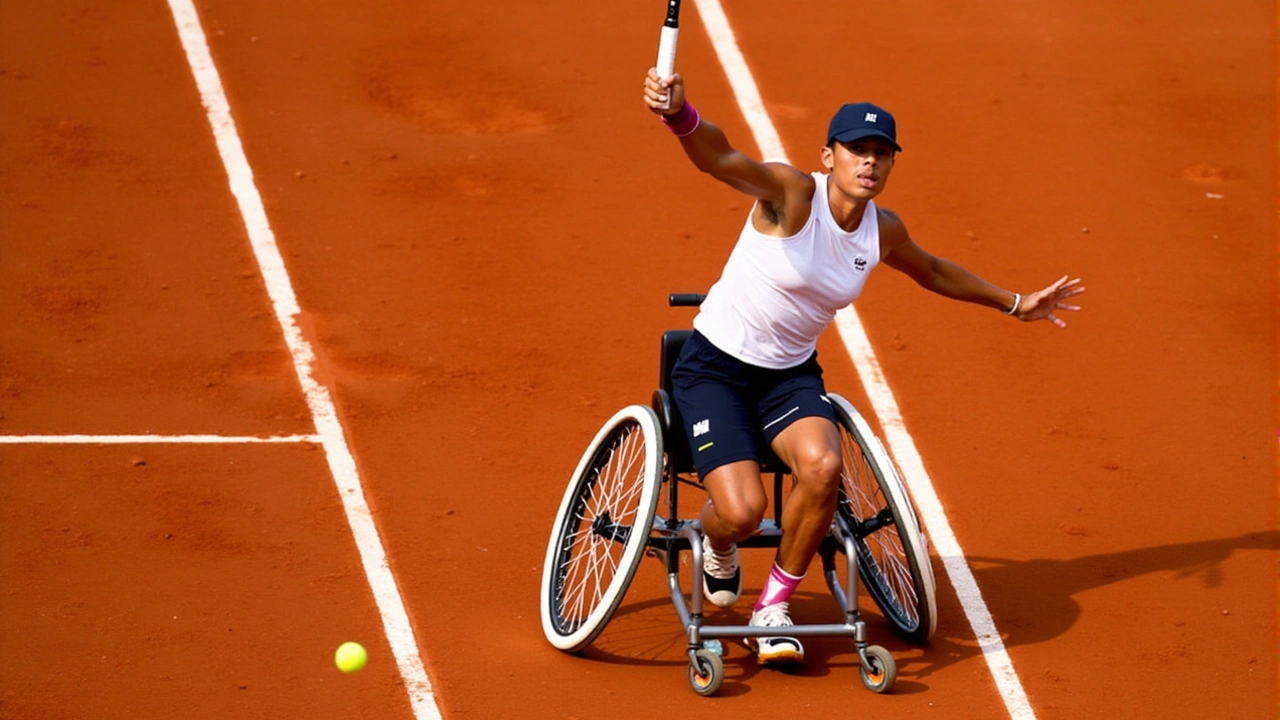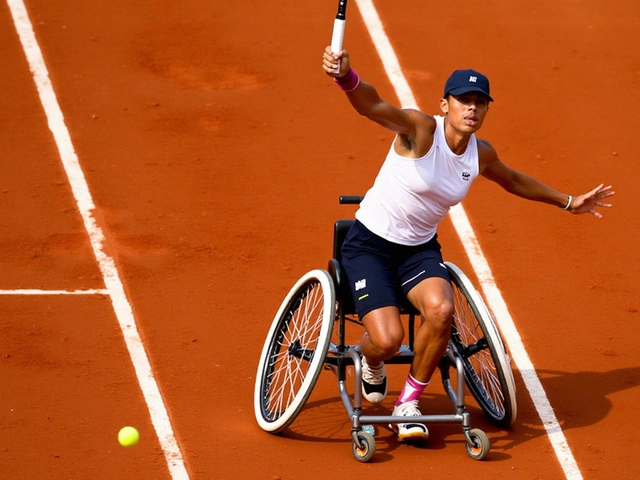Revolutionizing Wheelchair Tennis Training with Innovative Drills
In the lead-up to the Paris 2024 Paralympic Games, wheelchair tennis players are enhancing their speed and performance with creative and innovative training drills. Speed is a critical element, especially on the clay courts of Roland-Garros where the ball's higher bounce demands quick reflexes and rapid directional changes. One of the key figures in this movement is Dutch quad player Niels Vink, a double medallist from Tokyo 2020, who has openly shared his enthusiasm for faster-paced matches, which suit his aggressive playing style.
Mastering the Clay Courts of Roland-Garros
The famed clay courts of Roland-Garros provide a unique set of challenges for wheelchair tennis players. The surface causes the ball to bounce higher, necessitating quicker movements and faster reaction times. To tackle these challenges head-on, top Dutch athletes such as Niels Vink, Diede de Groot, Aniek van Koot, and Sam Schroder have been incorporating a variety of speed drills into their training regimens.
The drills themselves, given whimsical names like 'spider' and 'butterfly,' require players to move rapidly in multiple directions - backwards, forwards, and sideways - effectively simulating the dynamic environment of a live match. These exercises are not just about improving physical fitness; they also hone the mental agility required to anticipate and react to an opponent's moves.
The Dutch Team's Unique Approach
The Dutch team also relies on other techniques to enhance their speed and agility. Friendly 100-meter sprints and wheelchair basketball games are regular activities in their training camps. Diede de Groot, who has been at the forefront of integrating these innovative methods, stresses the importance of explosive power in their sport. She often measures progress meticulously, ensuring that each drill delivers quantifiable improvements.
Practices like these not only build up the physical endurance of the players but also foster a sense of camaraderie and friendly competition within the team. This holistic approach to training has proven essential in preparing them for high-stakes tournaments.
Insights from Argentine Star Gustavo Fernandez
Beyond the Dutch camp, Argentine athlete Gustavo Fernandez, a five-time Grand Slam winner, has also shared his focus on short-distance exercises to boost upper body strength and court mobility. His regime includes 10-meter and 5-meter sprints, which are designed to fortify his bursts of speed and sharp lateral movements.
Despite facing a dearth of competition within Argentina, Fernandez proposes the idea of a 100-meter sprint competition among international players, reflecting his belief in speed training as a critical aspect of the sport. His routine underscores that even in isolated training environments, creative drill designs can lead to substantive gains.
Diede de Groot's Early Start
Diede de Groot's journey in wheelchair tennis began with fun and engaging activities like wheelchair tag, which laid the groundwork for her remarkable agility and speed on the court. This playful start is a testament to how incorporating fun elements into training can lead to exceptional athletic prowess over time.
De Groot has continued to build on these early experiences, integrating more complex and demanding drills as her career has progressed. Her story highlights the importance of blending enjoyment with hard work in athletic training, a balance that has clearly paid off given her successful career.
Gordon Reid's Competitive Spirit
Another noteworthy mention is British player Gordon Reid, a four-time Paralympic medallist, who proudly recounted his victory in a 100-meter sprint during a recent training camp. This accomplishment not only enhanced his physical capabilities but also boosted his confidence and competitive spirit.
Reid's experience demonstrates how incorporating competitive exercises into training can provide athletes with both physical advantages and a psychological edge. Such drills enable players to simulate the high-pressure situations they will face during actual matches, better preparing them for the rigors of the tournament.
Conclusion: A New Era in Wheelchair Tennis Training
The innovative and fun training methods employed by these top-tier wheelchair tennis players are revolutionizing the way they prepare for competitions. By focusing on speed, agility, and explosive power, and by maintaining a balance of enjoyment and rigor, athletes like Niels Vink, Diede de Groot, and Gustavo Fernandez are setting new standards in the sport.
As we look forward to the Paris 2024 Paralympic Games, it is evident that these creative approaches will play a critical role in elevating the performance of wheelchair tennis players on the global stage.



Sanjay Verma
September 4, 2024 AT 08:43The 'spider' and 'butterfly' drills sound insane but brilliant 😍 I’ve seen some footage of Diede moving like a ghost on clay-how is that even possible? These drills aren’t just about speed, they’re about neural rewiring. Imagine training your brain to predict where the ball’s going before your eyes fully register it. This is next-level sport science.
surabhi chaurasia
September 5, 2024 AT 09:16This is just showing off. Why do they need all these fancy drills? Just play tennis. Back in my day, we just practiced and that was enough. Now everything has to be a video game.
Amresh Singh knowledge
September 6, 2024 AT 13:57The structured integration of agility drills with psychological conditioning represents a paradigm shift in adaptive athletics. The emphasis on quantifiable metrics, as demonstrated by De Groot, aligns with evidence-based performance optimization frameworks. This methodology deserves broader adoption across Paralympic disciplines.
Rahul Madhukumar
September 7, 2024 AT 14:03Wait… so now they’re doing 100m sprints in wheelchairs? 🤔 Who decided this was a good idea? I bet the IOC is just trying to make it look like they care about disabled athletes while secretly cutting funding elsewhere. And why is everyone from the Netherlands winning everything? Coincidence? I think not.
Khushi Thakur
September 9, 2024 AT 02:24There’s a profound existential truth here: speed is not merely physical-it is the manifestation of will made visible. Each lateral shift, each explosive pivot, is a silent scream against the limitations imposed by a world that still sees disability as absence. These athletes don’t just train-they transmute suffering into poetry.
Varad Tambolkar
September 9, 2024 AT 09:30100m sprint in a wheelchair? I’ve seen the videos. They’re not even moving fast. It’s all staged. I’m 100% sure this is just for the cameras. Also, why are all the top players Dutch? Are they getting secret tech from the EU? I’ve got sources. Don’t believe the hype.
Vijay Paul
September 9, 2024 AT 10:47The blend of fun and function in these drills is exactly what sports needs more of. Whether it’s wheelchair tag or basketball drills, keeping it engaging ensures long-term adherence. This isn’t just about winning medals-it’s about building lifelong resilience.
RUPESH BUKE
September 10, 2024 AT 23:14Gustavo’s 5m sprints are genius simple and effective
Chirag Kamra
September 11, 2024 AT 12:12OMG the butterfly drill?? I’d be dead after 2 mins 😭 but these peeps are monsters. I watched Niels Vink go full ninja on clay and my jaw dropped. Also, who else thinks we need a Wheelchair Tennis Olympics 100m race?? Like, actual medal ceremony, anthem, the whole thing?? I’d watch that.
Ramesh Velusamy
September 13, 2024 AT 10:03Diede’s tag games as a kid? That’s the secret right there. Fun first, then fire. You don’t build elite athletes by forcing drills-you build them by letting them fall in love with movement. I’ve coached 3 kids with spinal injuries and the ones who smiled while training? They’re the ones now crushing nationals. Keep it real. Keep it playful. The speed comes later.